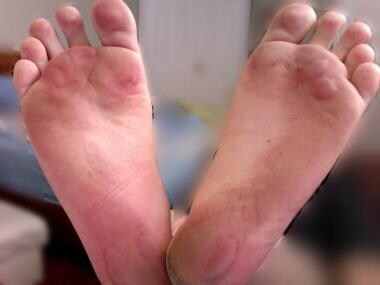Practice Essentials
Friction blisters of the skin commonly occur in active populations. They are the result of frictional forces between the involved skin area and the object with which the skin is in contact. Friction blisters create localized discomfort; however, they should not be taken lightly because secondary impetigo may become a serious complication with resulting cellulitis and sepsis. [1]
The bulk of research on friction blisters comes from the military because of the nature of the physical activity involved in this field. Friction blisters have also received much attention in the field of sports medicine.
See the image below.
Signs and symptoms
Discrete bullae formation at sites of trauma is evident, as seen in the image above.
Friction blisters tend to occur in areas of thick adherent stratum corneum (eg, palms, soles, heels, dorsa of fingers). In regions of the body where the stratum corneum is thinner, a repeated friction force causes the stratum corneum to erode, and instead of a blister, an erosion or abrasion occurs. Children often present with poorly fitting shoes and reporting a blister on the heel.
The likelihood of forming a friction blister at susceptible sites is based on the magnitude of the frictional force and the number of times an object moves across the skin (ie, shear cycles).
Pathophysiology
The influence of epidermal hydration on the friction of human skin against textiles was studied. Increasing cutaneous hydration may cause sex-specific changes in the mechanical properties and/or surface topography of human skin, leading to skin softening and increased real contact area and adhesion. [9]
Studies involving rubbing the skin with a constant force show an initial slight exfoliation of the skin over the involved area. Focally, mild erythema also develops. The patient may experience stinging or burning, while a zone of pallor develops around the erythematous area. The pallor eventually extends into the region of erythema and this area develops into a blister.
The effect of wearing socks with different frictional properties on plantar shear was studied because this is a possible mechanical risk factor for foot lesion development. [10] Wearing socks with low friction against the foot skin reduced the plantar shear force on the skin more than a sock with low friction against the insole.
Friction blister formation is affected by epidermal hydration. In a study of 11 men and 11 women, the friction between the inner forearm and a hospital fabric was measured in different hydration states. [11] Increasing skin hydration caused sex-specific changes in the mechanical properties and/or surface topography, as the friction of female skin demonstrated significantly higher moisture sensitivity.
Technology such as thermographic images may facilitate assessment of traumatically damaged foot skin. [12]
Etiology
Poorly fitting shoes are the most common cause. Heat, sweating, and maceration of the skin may predispose to friction blister formation. A study of foot blister formation in 3 groups of 11 participants showed biomechanical interactions on the plantar surface of individuals prone to blisters to be at variance from less predisposed to this finding. [13] Wearing wet socks was found to enhance the risk of foot blisters in hikers. [14] Baseball pitchers suffer repeated trauma between the baseball seams and the fingers of the pitching hand, most often at the tips of the index and long fingers. [2] An unusual case of a climbing harness causing a flank friction blister has been reported. [15]
Epidemiology
During the first Iraqi War, the prevalence of foot friction blisters among American troops was 33%, of which 11% required medical care. [16]
No known predilection is reported for any particular race.
No known predilection is described for either sex. Women aged 26-34 years who are unable to break in their boots and have a past history of blisters, were the most likely to develop friction blisters among American troops during the first Iraqi War. [16]
No known predilection is apparent for any age group.
Prognosis
Friction blisters create localized discomfort; however, they should not be taken lightly because secondary impetigo may become a serious complication with resulting cellulitis and sepsis.
Patient Education
Educate patients about the importance of prevention measures (see Prevention).
-
Friction blisters on human foot. Courtesy of Andry French (own work), via Wikimedia Commons.


